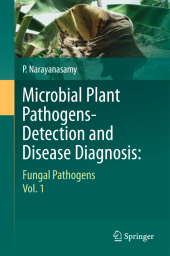 Neuerscheinungen 2014Stand: 2020-02-01 |
Schnellsuche
ISBN/Stichwort/Autor
|
Herderstraße 10
10625 Berlin
Tel.: 030 315 714 16
Fax 030 315 714 14
info@buchspektrum.de |

P. Narayanasamy
Microbial Plant Pathogens-Detection and Disease Diagnosis:
Fungal Pathogens, Vol.1
2011. 2014. xxii, 291 S. 10 Tabellen. 235 mm
Verlag/Jahr: SPRINGER NETHERLANDS; SPRINGER 2014
ISBN: 9400789769 (9400789769)
Neue ISBN: 978-9400789760 (9789400789760)
Preis und Lieferzeit: Bitte klicken
This volume is an exhaustive compendium of various methods of detecting fungal pathogens, and diagnosing the diseases caused by them. It is based on an extensive literature survey and is a valuable tool in selecting appropriate investigative techniques.
Morphological, biological, biochemical and physiological characteristics have been used for the detection, identification and differentiation of fungal pathogens up to species level. Tests based on biological characteristics are less consistent. Immunoassays have been shown to be effective in detecting fungal pathogens present in plants and environmental samples. Development of monoclonal antibody technology has greatly enhanced the sensitivity and specificity of detection, identification and differentiation of fungal species and varieties/strains. Nucleic acid-based techniques involving hybridization with or amplification of unique DNA have provided results rapidly and reliably. Presentation of a large number of protocols is a unique feature of this volume.
Volume 1
Chapter 1 Introduction
1.1 Microbial plant pathogens as a major limiting factor of crop production
1.2 Discovery of fungi as plant pathogens
1.3 Detection of fungal plant pathogens and disease diagnosis
References
Chapter 2 Detection of Fungal Pathogens in Plants
2.1 Detection of fungal pathogens in plant organs
2.1.1 Biological methods 2.1.2 Pathogenicity and host range
2.1.3 Biochemical methods
2.1.4 Immunoassays
2.1.5 Nucleic acid-based detection techniques
2.2 Detection of fungal pathogens in seeds and planting materials
2.2.1 Detection of fungal pathogens in seeds
2.2.2 Detection of fungal pathogens in propagative planting materials
2.2.3 Detection of fungal pathogens in postharvest produce
Appendix
References
Chapter 3 Detection of Fungal Pathogens in the Environment
3.1 Detection of fungal pathogens in soil
3.1.1 Bioassays
3.1.2 Immunoassays
3.1.3 Nucleic acid-based techniques
3.2 Detection of fungal pathogens in water
3.2.1 Immunoassays
3.2.2 Nucleic acid-based techniques
3.3 Detection of fungal pathogens in air
3.4 Detection of fungal pathogens in alternative host plants
Appendix
References
Chapter 4 Assessment of Variability in Fungal Plant Pathogens
4.1 Methods of assessment of variability in fungal pathogens
4.1.1 Assessment of variations in biological characteristics
4.1.2 Assessment of variations in biochemical characteristics
4.1.3 Assessment of variations in immunological characteristics
4.1.4 Assessment of variations in genomic characteristics
4.2 Assessment of variability in sensitivity to chemicals
4.2.1 Assessment of variations in biological characteristics
4.2.2 Assessment of variations in genetic characteristics
Appendix
References
Chapter 5 Diagnosis of Fungal Diseases of Plants
5.1 Choice of diagnostic tests for fungal pathogens
5.1.1 Conventional methods
5.1.2 Molecular methods
5.2 Agencies involved in disease diagnosis
5.2.1 Disease diagnostic centers
5.2.2 Plant quarantines
References
From the reviews:
"The first volume of the Microbial plant pathogens - Detection and disease diagnosis focuses on fungal pathogens. ... All chapters are summarized in the abstract, well referenced and focused on providing concerns of techniques and improvements of research. Therefore, if you are interested in the methods for detection and diagnosis, this is certainly a book you must have. The book should be available to every mycologist and students studying any aspect of plant pathology. Every library in the world should also have this book." (Dhanushka Udayanga and Dimuthu S. Manamgoda, Fungal Diversity, April, 2012)


